Reminiscing
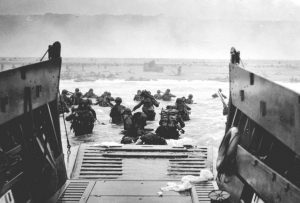 Most people from the Baby Boomer Generation know the significance of D-Day, but it occurs to me that many people in the younger generations may not really know what it was all about. Operation Overlord was the Allied invasion of northern France, commonly known as D-Day. The operation was under the direction of Supreme Allied Commander General Dwight D. Eisenhower. The operation had a brief 3 day window in which to take place, and June 5th had been chosen to be the day, but the day dawned gloomy, so the operation had to be scrubbed for the day.
Most people from the Baby Boomer Generation know the significance of D-Day, but it occurs to me that many people in the younger generations may not really know what it was all about. Operation Overlord was the Allied invasion of northern France, commonly known as D-Day. The operation was under the direction of Supreme Allied Commander General Dwight D. Eisenhower. The operation had a brief 3 day window in which to take place, and June 5th had been chosen to be the day, but the day dawned gloomy, so the operation had to be scrubbed for the day.
Then on June 6th, the orders came down that Operation Overlord was a go. By daybreak, 18,000 British and American parachutists were already on the ground. An additional 13,000 aircraft were mobilized to provide air cover and support for the invasion, among them the B-17, Raggedy Ann, which was carrying my dad, Allen Spencer, who was a Top Turret Gunner and Flight Engineer. At 6:30 am, American troops came ashore at Utah and Omaha beaches. The British and Canadians overcame light opposition to capture Gold, Juno and Sword beaches, as did the Americans at Utah. Omaha beach was a much different situation, however, where the US First Division battled high seas, mist, mines, burning vehicles, and German coastal batteries, including an elite infantry division, which spewed heavy fire. Many wounded Americans ultimately drowned in the high tide. British divisions, which landed at Gold, Juno, and Sword beaches, and Canadian troops also met with heavy German fire.

The troops persevered, even though the loses were great, and in the end the operation was declared a victory. There were many reasons that D-Day was successful, even against all odds. The Allies had fooled the Germans, who thought the attack was going to occur farther along the coast at Calais because this was the shortest route by sea, even when the attack began on the beaches Hitler was still convinced the attack was going to occur at Calais. What a shock that must have been when he found out that the attack took place on the beaches of Normandy. False intelligence spread by the allies spread false information to the Germans, and they bought it.
There were many factors that all worked together to make the plan work. Wooden guns on the South Coast of England, wooden planes, dropped plastic dummies out of planes, they put mirrors up on their ships and the Germans were fooled as they saw themselves going the other way. New technology specifically designed for the landing enabled the Allies to gain an advantage over the Germans. Mulberries, the floating docks the Allies used to land, enabled the Allies to land safely and disembark while firing. Some of the beaches were practically empty, however, on Omaha beach the Allies suffered heavy losses numbering 2000 in total. Operation Overlord had been planned for many years and so they were ready. The Germans had to keep control of the other parts of their empires, so their troops were elsewhere. Hitler denied that his forces were losing in Normandy, and  would not authorize the mobilization of forces stationed near Normandy.
would not authorize the mobilization of forces stationed near Normandy.
As for the Allies, the troops involved were highly trained, equipped and motivated. Their battle plan was well prepared. All the necessary manpower and logistics were available to them. The air space was controlled by the Allies. The sea lanes were very short and the seas were in Allied hands. The deception plan was flawless. The Germans had no idea what was coming. The French Resistance was highly effective. The German troop who were there were poorly motivated. Hitler’s Defense Planning was completely flawed. But, the biggest victory is that the troops did their job.
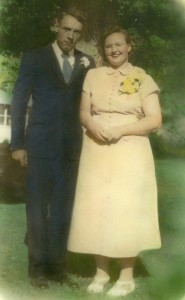 World War II had been ended four years earlier, and people were getting back to their lives. The year was 1949, and the date was June 6th. My future in-laws had other things on their minds. Today, June 6, 1949 was the day they would be married. I wonder if they were even aware of the significance of the day, but if they were, I’m sure they paused for a few moments to remember the men who that very day, just five years earlier, when one of the biggest operations in World War II was carried out. The war was over, but the aftermath was still very fresh on everyone’s minds. Still, life goes on, and while we commemorate the important days in history, we can’t usually avoid of all of them when it comes to life events that come after.
World War II had been ended four years earlier, and people were getting back to their lives. The year was 1949, and the date was June 6th. My future in-laws had other things on their minds. Today, June 6, 1949 was the day they would be married. I wonder if they were even aware of the significance of the day, but if they were, I’m sure they paused for a few moments to remember the men who that very day, just five years earlier, when one of the biggest operations in World War II was carried out. The war was over, but the aftermath was still very fresh on everyone’s minds. Still, life goes on, and while we commemorate the important days in history, we can’t usually avoid of all of them when it comes to life events that come after.
Weddings in those days were not the elaborate affairs they often are today, but rather were set to times when people might already be planning to be in town. My mother-in-law, Joanne (Knox) Schulenberg wore a simple light peach colored dress and flat shoes. For those who don’t know my mother-in-law, seeing her in a dress of any style  was amazing, because she practically lived on a horse, and dresses simply weren’t done. I never saw her in high heels, or any kind of a heel at all, so the flat white Mary Jane type of shoe was as dressy as it gets. My father-in-law, Walt Schulenberg, was equally out of character for his wardrobe style. He didn’t usually wear a suit unless he was going to a funeral. For that reason, seeing them dressed up shows just how special this day was to them. Of course, people in those days didn’t get married in some of the outlandishly casual outfits that we sometime see these days.
was amazing, because she practically lived on a horse, and dresses simply weren’t done. I never saw her in high heels, or any kind of a heel at all, so the flat white Mary Jane type of shoe was as dressy as it gets. My father-in-law, Walt Schulenberg, was equally out of character for his wardrobe style. He didn’t usually wear a suit unless he was going to a funeral. For that reason, seeing them dressed up shows just how special this day was to them. Of course, people in those days didn’t get married in some of the outlandishly casual outfits that we sometime see these days.

The day turned out beautifully, and while I’m not sure if theirs was an outdoor wedding or not, I rather doubt it, because in those days, you didn’t see very many of those, but I could be wrong too. Nevertheless, the day was sunny and without rain, and the wedding went off without a hitch, and their married life began. They would go on to have six children, four girls and two boys. Life would take the family from Forsyth, Montana to Casper, Wyoming in the end. While Dad left us in May of 2013, Mom was with us until January of 2018. Their love was never ending. Today would have been their 70th wedding anniversary. Happy anniversary in Heaven, Mom and Dad. We love and miss you very much.
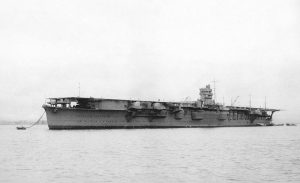 The Japanese had a tendency to be sneaky about their weapons of warfare, and their attack plans, as we know from Pearl Harbor. One such well kept secret was the Hiryu…which means Flying Dragon. The ship was a modified Soryu design that was built exclusively for the Imperial Japanese Navy. The Soryu, which means Blue Dragon, was built first, and because of the heavy modifications, the Hiryu was almost considered to be a separate class of ship. Hiryu had a displacement of 17,600 tons, length of 746 feet 1 inch, beam of 73 feet 2 inches, draft of 25 feet 7 inches and a speed of 34 knots. Built in 1931, “these two ships became prototypes for almost all subsequent Japanese carriers. They had continuous flight deck, two-level hangar, small island superstructure, two deflexed down and aft funnels and three elevators. As a whole ship design (within the limits of displacement assigned on it) has appeared rather successful, harmoniously combining high speed with strong AA armament and impressive number of air group.” The Hiryu, unlike the small height hangar levels of the Soryu, was built to an advanced design. “Her freeboard height was increased by one deck, island was transferred to a port side (Hiryu became second after Akagi and last Japanese carrier with an island on a port side). Breadth of a flight deck was increased on 1m, a fuel stowage on 20%. She had a little strengthened protection: belt thickness abreast machinery raised to 48mm.”
The Japanese had a tendency to be sneaky about their weapons of warfare, and their attack plans, as we know from Pearl Harbor. One such well kept secret was the Hiryu…which means Flying Dragon. The ship was a modified Soryu design that was built exclusively for the Imperial Japanese Navy. The Soryu, which means Blue Dragon, was built first, and because of the heavy modifications, the Hiryu was almost considered to be a separate class of ship. Hiryu had a displacement of 17,600 tons, length of 746 feet 1 inch, beam of 73 feet 2 inches, draft of 25 feet 7 inches and a speed of 34 knots. Built in 1931, “these two ships became prototypes for almost all subsequent Japanese carriers. They had continuous flight deck, two-level hangar, small island superstructure, two deflexed down and aft funnels and three elevators. As a whole ship design (within the limits of displacement assigned on it) has appeared rather successful, harmoniously combining high speed with strong AA armament and impressive number of air group.” The Hiryu, unlike the small height hangar levels of the Soryu, was built to an advanced design. “Her freeboard height was increased by one deck, island was transferred to a port side (Hiryu became second after Akagi and last Japanese carrier with an island on a port side). Breadth of a flight deck was increased on 1m, a fuel stowage on 20%. She had a little strengthened protection: belt thickness abreast machinery raised to 48mm.”
Hiryu took part in Japanese invasion of French Indochina (Now Vietnam, Cambodia and Laos) in mid 1940s, the attack on Pearl Harbor and the Battle of Wake Island. The ship became a great enemy of the Allies. Then, along with three other fleet carriers, Hiryu participated in the Battle of Midway Atoll in North Pacific Ocean in June 1942. Initially, the Japanese forces managed to bombard US forces on the atoll. It didn’t look good for the 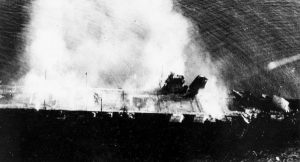 Allies, but on June 4, 1942, the Japanese aircraft carriers were attacked by dive-bomber aircraft from USS Enterprise, USS Yorktown, USS Hornet, and Midway Atoll. Hiryu was hit and severely crippled, and was set on fire. Japanese destroyer Makigumo torpedoed Hiryu on June 5, 1942 at 05:10 am, because she could not be salvaged. Only 39 men survived as after 4 hours, she sank with bodies of 389 men. Three other Japanese carriers were also sunk during the Battle of Midway. It was a battle that brought Japan’s first naval defeat since the Battle of Shimonoseki Straits in 1863. It was a great day for the Allies.
Allies, but on June 4, 1942, the Japanese aircraft carriers were attacked by dive-bomber aircraft from USS Enterprise, USS Yorktown, USS Hornet, and Midway Atoll. Hiryu was hit and severely crippled, and was set on fire. Japanese destroyer Makigumo torpedoed Hiryu on June 5, 1942 at 05:10 am, because she could not be salvaged. Only 39 men survived as after 4 hours, she sank with bodies of 389 men. Three other Japanese carriers were also sunk during the Battle of Midway. It was a battle that brought Japan’s first naval defeat since the Battle of Shimonoseki Straits in 1863. It was a great day for the Allies.
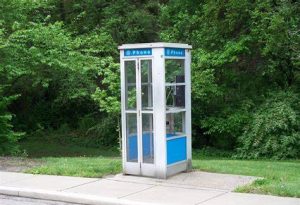 The current generation of kids probably have no idea what a phone booth is, besides maybe a place for Superman to change into his costume. From the time phones first became something that was provided to the public for a fee, phone booths became a common sight on city streets. Then in the 1950s, a new fad began. Much like the fad of stuffing as many people as possible into a car, people decided to stuff as many people as possible into a phone booth. My guess is that like most of these strange fads, this one too,
The current generation of kids probably have no idea what a phone booth is, besides maybe a place for Superman to change into his costume. From the time phones first became something that was provided to the public for a fee, phone booths became a common sight on city streets. Then in the 1950s, a new fad began. Much like the fad of stuffing as many people as possible into a car, people decided to stuff as many people as possible into a phone booth. My guess is that like most of these strange fads, this one too,  was practiced mostly by young people.
was practiced mostly by young people.
Phone booth stuffing first gained popularity outside the United States, but once it arrived stateside, in spring 1959, kids couldn’t help but join in. Basically, people would cram their bodies into the narrow spaces like sardines in a can. Some adopted other methods, such as stacking themselves horizontally. Just imagine being the guy on the bottom of the stack. All I can say is, “Hurry up, because I can’t breathe!!”
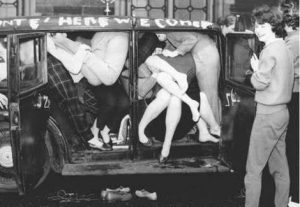 As with so many other crazy fad, phone booth stuffing became something to set a world record for. People began trying to outdo the prior record. The word record for phone-booth stuffing came in March 1959, when 25 people in South Africa piled into a booth. I can’t imagine how they could possibly fit 25 people in a phone booth, but while they were all in there, the phone rang. Of course, nobody answered the phone, because nobody could move enough to reach it. Sadly, the trend died by the end of 1959. Of course, that doesn’t mean that some of the other stuffing trends didn’t continue. I think people are still stuffing as many people as they can into a car. I just hope they don’t try to drive that way.
As with so many other crazy fad, phone booth stuffing became something to set a world record for. People began trying to outdo the prior record. The word record for phone-booth stuffing came in March 1959, when 25 people in South Africa piled into a booth. I can’t imagine how they could possibly fit 25 people in a phone booth, but while they were all in there, the phone rang. Of course, nobody answered the phone, because nobody could move enough to reach it. Sadly, the trend died by the end of 1959. Of course, that doesn’t mean that some of the other stuffing trends didn’t continue. I think people are still stuffing as many people as they can into a car. I just hope they don’t try to drive that way.
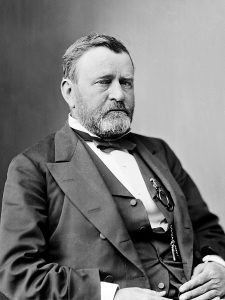 Often we think that the best course of action is to simply attack a problem head on, but that is not always true, as Union General Ulysses S. Grant would find out on June 3, 1864. The United States was deep into the Civil War, and on that particular day, and the Confederate Army was entrenched at Cold Harbor, Virginia. General Grant was about to make the greatest mistakes of his career.
Often we think that the best course of action is to simply attack a problem head on, but that is not always true, as Union General Ulysses S. Grant would find out on June 3, 1864. The United States was deep into the Civil War, and on that particular day, and the Confederate Army was entrenched at Cold Harbor, Virginia. General Grant was about to make the greatest mistakes of his career.
Since the battle began on May 31st, Grant’s Army of the Potomac and Robert E. Lee’s Army of Northern Virginia had inflicted frightful losses upon each other as they worked their way around Richmond, Virginia…from the Wilderness forest to Spotsylvania and numerous smaller battle sites…the previous month. On May 30, Lee and Grant collided  at Bethesda Church. The next day the battle began when the advance units of the armies arrived at the crossroads of Cold Harbor, which was just 10 miles from Richmond, Virginia. There, a Yankee attack seized the intersection. Grant decided that this was the perfect chance to destroy Lee at the gates of Richmond, Grant prepared for a major assault along the entire Confederate front on June 2nd, but his plan was delayed because the necessary troops…Winfield Hancock’s Union corps did not arrive on schedule, the operation was delayed until the following day.
at Bethesda Church. The next day the battle began when the advance units of the armies arrived at the crossroads of Cold Harbor, which was just 10 miles from Richmond, Virginia. There, a Yankee attack seized the intersection. Grant decided that this was the perfect chance to destroy Lee at the gates of Richmond, Grant prepared for a major assault along the entire Confederate front on June 2nd, but his plan was delayed because the necessary troops…Winfield Hancock’s Union corps did not arrive on schedule, the operation was delayed until the following day.
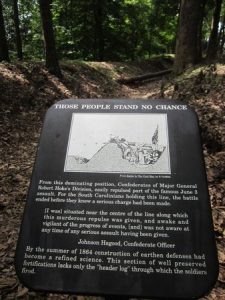
The delay was a tragic move for the Union army, because it gave Lee’s troops time to entrench. Grant was frustrated with the prolonged pursuit of Lee’s army, so he gave the order to attack on June 3, but the entrenched Confederate army had the protection of deep trenches atop a hill, making the Union army have to attack without cover. It was a decision that resulted in a complete disaster. The Yankees were met with murderous fire, and were only able to reach the Confederate trenches in a few places. The 7,000 Union casualties, compared to only 1,500 for the Confederates, were all lost in under an hour. A dejected Grant pulled out of Cold Harbor nine days later and continued to try to flank Lee’s army. His next stop was Petersburg, south of Richmond, where he forced a nine-month siege. While Petersburg would redeem him some, there would be no more attacks on the scale of Cold Harbor.
 My sister, Alena Stevens has had a dream for a number of years now…to be a grandma. That dream finally came true almost a year ago when her little granddaughter, Elliott Michelle Stevens was born on August 3, 2018, which is also our grandmother, Anna Schumacher Spencer’s birthday. I know she would have been so happy to have her great great granddaughter born on her birthday. Grandbabies are always wonderful, and it’s especially cool when they become a birthday present too. And it’s cool for everyone, from the parents to the grandparents.
My sister, Alena Stevens has had a dream for a number of years now…to be a grandma. That dream finally came true almost a year ago when her little granddaughter, Elliott Michelle Stevens was born on August 3, 2018, which is also our grandmother, Anna Schumacher Spencer’s birthday. I know she would have been so happy to have her great great granddaughter born on her birthday. Grandbabies are always wonderful, and it’s especially cool when they become a birthday present too. And it’s cool for everyone, from the parents to the grandparents.
Alena has worked for the Natrona County School District as the Refocus Room teacher  for a number of years now. She says that she really has a heart for helping these students get themselves back on track. She understands the emotions they sometimes deal with, and that is not always easy to do. Working in the school district also gives her the summers off, as well as any school holidays and national holidays. That is going to be especially nice for her now, because her son, Garrett, daughter-in-law, Kayla, and little Elliott live in Sheridan and Alena lives in Casper, making it difficult to visit during the school year. Thankfully Sheridan isn’t that far away, so visits are possible on the weekends too.
for a number of years now. She says that she really has a heart for helping these students get themselves back on track. She understands the emotions they sometimes deal with, and that is not always easy to do. Working in the school district also gives her the summers off, as well as any school holidays and national holidays. That is going to be especially nice for her now, because her son, Garrett, daughter-in-law, Kayla, and little Elliott live in Sheridan and Alena lives in Casper, making it difficult to visit during the school year. Thankfully Sheridan isn’t that far away, so visits are possible on the weekends too.

Alena is a teacher in the Refocus Room at Verda James School, but she is also a great hairstylist and a great interior decorator too. Her home is beautifully decorated, with a style that some of us can only dream of producing in our own homes. She uses everything from wallpaper to stencils to dual colors in a room, to create a warmth and beauty that is just stunning. It is a talent that I wish I had, but I believe it is a gift that not everyone is given. She has an eye for it for sure, and that is what it takes to envision the way a room will look once you put your ideas in place. Today is Alena’s birthday. Happy birthday Alena!! Have a great day!! We love you!!

 Shortly after our daughter, Amy (Schulenberg) Royce was born, we knew that she was destined to be…little, but only in stature. At just 4 feet 10 inches tall, Amy is quite short, a full 3 inches shorter that her not very tall sister, Corrie (Schulenberg) Petersen. Nevertheless, when it comes to her personality, abilities, intelligence, and her kind heart…she somehow packs a whole lot into that tiny frame. Amy has always lived her life well beyond her size, and nobody ever tried to tell her she couldn’t do something, because she knew that she could do anything she put her mind to.
Shortly after our daughter, Amy (Schulenberg) Royce was born, we knew that she was destined to be…little, but only in stature. At just 4 feet 10 inches tall, Amy is quite short, a full 3 inches shorter that her not very tall sister, Corrie (Schulenberg) Petersen. Nevertheless, when it comes to her personality, abilities, intelligence, and her kind heart…she somehow packs a whole lot into that tiny frame. Amy has always lived her life well beyond her size, and nobody ever tried to tell her she couldn’t do something, because she knew that she could do anything she put her mind to.
When Amy met her husband, Travis, she was very quickly sure that this guy was the one who could keep the fun and laughter in her life, and he certainly has done that. His favorite nick name for her is Midget, and I must admit that it fits. Partly because of her size, Travis loves midget wrestling, which has become a thing these days. Who would have known. That’s the thing she loved about him. He could turn most situations into something fun and full of humor.
Amy first began working in the insurance industry at the young age of 15, when she worked in the office I worked in doing filing, phones, and typing. I was just trying to help her get a job as a kid, who knew that it would be the beginning of a future lifelong career for her. During her teen years, she needed more hours than we could give her, so she went to work in fast food, and then on to daycare, the hotel industry, and an office job in an industrial training facility. Then her journey came full circle, when she was hired in the insurance office I was working at then…The Stengel Agency. It was there that she got licenses, and became an excellent insurance agent. When her family decided to move to Washington state, her insurance background netted her several job offers. Now things have come full circle again…so to speak, because her daughter, Shai Royce, who 
 also worked with us at The Stengel Agency, is now working at the same agency that Amy, her mom, works at now…Rice Insurance, and they are both very excited about that. Sometimes it is all in who you know, but I think insurance is in their blood, because if you can’t understand insurance, you will never be a good agent. They both understand insurance, just like their mom and grandma…me. Today is Amy’s birthday, and I am very excited for this new aspect of her life…sharing a career with her daughter and friend. Not bad for a midget!! Happy birthday Amy!! Have a great day!! We love you!!
also worked with us at The Stengel Agency, is now working at the same agency that Amy, her mom, works at now…Rice Insurance, and they are both very excited about that. Sometimes it is all in who you know, but I think insurance is in their blood, because if you can’t understand insurance, you will never be a good agent. They both understand insurance, just like their mom and grandma…me. Today is Amy’s birthday, and I am very excited for this new aspect of her life…sharing a career with her daughter and friend. Not bad for a midget!! Happy birthday Amy!! Have a great day!! We love you!!

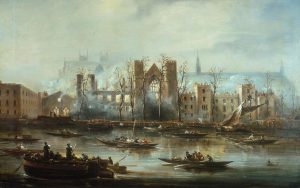 I think most people have heard of Big Ben, the famous clock tower in London, but what you may not know is that originally, there was no clock and no tower. The Houses of Parliament and Elizabeth Tower, most often called Big Ben, are among London’s most iconic landmarks and favorite London attractions. Big Ben is actually the name that was given to the massive bell inside the clock tower, which weighs more than 13 tons, not to the clock or the tower. At night the four clock faces are illuminated, and the effect is spectacular.
I think most people have heard of Big Ben, the famous clock tower in London, but what you may not know is that originally, there was no clock and no tower. The Houses of Parliament and Elizabeth Tower, most often called Big Ben, are among London’s most iconic landmarks and favorite London attractions. Big Ben is actually the name that was given to the massive bell inside the clock tower, which weighs more than 13 tons, not to the clock or the tower. At night the four clock faces are illuminated, and the effect is spectacular.
The British Parliament is located in the Palace of Westminster. In October of 1834, a fire destroyed much of the palace and it had to be rebuilt. At that time it was decided that there would be an spectacular addition of a clock at the top of a tower. The clock is magnificent. Each dial measures almost 23 feet in diameter. The hands are 14 feet long and weigh about 220 pounds, including counterweights. The numbers on the clock’s face are approximately 23 inches long. There are 312 pieces of glass in each clock dial. When parliament is in session, a special light above the clock faces is illuminated. Big Ben’s timekeeping is strictly regulated by a stack of coins placed on the huge pendulum. Big Ben has rarely stopped. Even after a bomb destroyed the Commons chamber during World War II, the clock tower survived and Big Ben continued to strike the hours. The chimes of Big Ben were first broadcast by the BBC on December 31, 1923. It is a tradition that continues to this day. The Latin words under the clock face read Domine Salvam Fac Reginam Nostram Victoriam Primam, which means “O Lord, keep safe our Queen Victoria the First.” In June 2012 the House of Commons announced that the clock tower was to be renamed the Elizabeth Tower in honor of Queen Elizabeth II’s Diamond Jubilee.
A massive bell was required and the first attempt made by John Warner and Sons at Stockton-On-Tees cracked irreparably. Big Ben first rang across Westminster on May 31, 1859. A short time later, in September 1859, Big 
 Ben cracked. The metal was melted down and the bell recast in Whitechapel in 1858. A lighter hammer was fitted and the bell rotated to present an undamaged section to the hammer. This is the bell as we hear it today, and the real owner of the name Big Ben. Elizabeth Tower stands at more than 105 yards tall, with 334 steps to climb up to the belfry and 399 steps to the Ayrton Light at the very top of the tower.
Ben cracked. The metal was melted down and the bell recast in Whitechapel in 1858. A lighter hammer was fitted and the bell rotated to present an undamaged section to the hammer. This is the bell as we hear it today, and the real owner of the name Big Ben. Elizabeth Tower stands at more than 105 yards tall, with 334 steps to climb up to the belfry and 399 steps to the Ayrton Light at the very top of the tower.

 My great grand nephew, Jaxx Harman is a sweet little two year old boy, with smiling eyes, and a great personality. He is easy going, probably the result of being the youngest of the three children of his parents, Melanie and Jake Harman, and little brother to two sisters, Alice and Izabella. When a little boy has a mom and two sisters all “mothering” him, he pretty much has to grow up to be very patient. Nevertheless, according to his mom, he can also be whiny and that probably gets him a little bit of leeway when it comes to being ordered around by his sisters.
My great grand nephew, Jaxx Harman is a sweet little two year old boy, with smiling eyes, and a great personality. He is easy going, probably the result of being the youngest of the three children of his parents, Melanie and Jake Harman, and little brother to two sisters, Alice and Izabella. When a little boy has a mom and two sisters all “mothering” him, he pretty much has to grow up to be very patient. Nevertheless, according to his mom, he can also be whiny and that probably gets him a little bit of leeway when it comes to being ordered around by his sisters.
Alice, being a bit older never had a problem saying Jaxx, but Izabella, being just 17 months older than her brother, has never called him anything, but Bletta!! While I’m sure that name will someday go away, at least as far as Belle is concerned, it will always be one that his parents and grandparents will cherish, and who knows, it may always be his nickname…after all, it is cute. Some nicknames are just destined to stick. Jaxx must like it because he doesn’t say anything about it, even though he is speaking very clearly these days. Of course, just about anything his sisters do is ok with Jaxx, and these days he is capable of following them around, and he likes that new-found ability, and the freedom it brings with it.
While Jaxx loves his sisters very much, a guy really does need to have buddies who share the same interests, 
 and lets face it, girls play differently than boys. That’s where Jaxx’s cousin once removed, Matthew Masterson comes in. Matt and Jaxx have a really great bond, and it doesn’t bother Matt to hang out with a cousin who is so much younger than his own 13 years. Maybe that’s because Matt is also the only boy in a family with three sisters, two of whom still live in the family home. That gives these boys something in common, and whenever Jaxx find out that Matt is coming over, or he is going to Matt’s house, he gets very excited. Finally, somebody who is on his side. Not to mention that Matt likes to hang out with him, which many times doesn’t happen with older boys and their younger cousins. Matt has a kind heart, and I’m sure that is in a big way the thing that attracts Jaxx to him. Today is Jaxx’s 2nd birthday. Happy birthday Jaxx!! Have a great day!! We love you!!
and lets face it, girls play differently than boys. That’s where Jaxx’s cousin once removed, Matthew Masterson comes in. Matt and Jaxx have a really great bond, and it doesn’t bother Matt to hang out with a cousin who is so much younger than his own 13 years. Maybe that’s because Matt is also the only boy in a family with three sisters, two of whom still live in the family home. That gives these boys something in common, and whenever Jaxx find out that Matt is coming over, or he is going to Matt’s house, he gets very excited. Finally, somebody who is on his side. Not to mention that Matt likes to hang out with him, which many times doesn’t happen with older boys and their younger cousins. Matt has a kind heart, and I’m sure that is in a big way the thing that attracts Jaxx to him. Today is Jaxx’s 2nd birthday. Happy birthday Jaxx!! Have a great day!! We love you!!
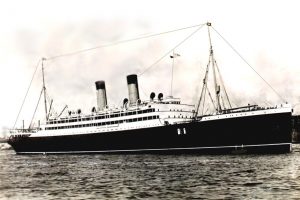 Two years after the sinking of the Titanic, the world was still very aware of the dangers of travel by ship. The Titanic was supposed to be unsinkable, and yet on April 14, 1912, it took more than 1500 people to the bottom of the Atlantic Ocean with it. Many safety precautions had changed since Titanic went down. The ship’s radio room had to be manned at all times, crews were trained extensively in emergency procedures, and ships were equipped more than enough lifejackets and lifeboats. Every precaution that they knew to take had been taken, making The Empress of Ireland one of the safest ships on Earth.
Two years after the sinking of the Titanic, the world was still very aware of the dangers of travel by ship. The Titanic was supposed to be unsinkable, and yet on April 14, 1912, it took more than 1500 people to the bottom of the Atlantic Ocean with it. Many safety precautions had changed since Titanic went down. The ship’s radio room had to be manned at all times, crews were trained extensively in emergency procedures, and ships were equipped more than enough lifejackets and lifeboats. Every precaution that they knew to take had been taken, making The Empress of Ireland one of the safest ships on Earth.
On May 29, 1914, The Empress of Ireland left Quebec Harbor on a  transatlantic journey to Liverpool England. She was sailing in heavy fog down Canada’s Saint Lawrence River, carrying 1477 passengers and crew. The Norwegian freighter Storstad was also sailing on the Saint Lawrence River on that fateful day. Sailing in heavy fog, without the modern GPS equipment to keep everyone informed of the ships’ positions, is a seriously dangerous undertaking. I don’t know that the normal protocol was for sailing in fog, but it would make sense to me that they should drop anchor and wait for the fog to lift before continuing on. I’m sure that these days, the ships would have some kind of protocol.
transatlantic journey to Liverpool England. She was sailing in heavy fog down Canada’s Saint Lawrence River, carrying 1477 passengers and crew. The Norwegian freighter Storstad was also sailing on the Saint Lawrence River on that fateful day. Sailing in heavy fog, without the modern GPS equipment to keep everyone informed of the ships’ positions, is a seriously dangerous undertaking. I don’t know that the normal protocol was for sailing in fog, but it would make sense to me that they should drop anchor and wait for the fog to lift before continuing on. I’m sure that these days, the ships would have some kind of protocol.
The Empress and the Storstad spotted each other several minutes before the inevitable collision, but altered 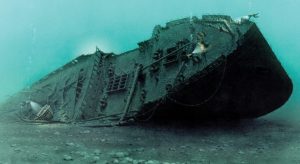 courses and confused signals brought them into the fateful moment of impact. I suppose that if each ship hadn’t moved in the same direction, they might have been able to avoid the collision, but unfortunately they did move in the same direction. The Storstad penetrated 15 feet into the Empress of Ireland‘s starboard side, and the vessel sunk within 14 minutes, drowning 1,012 of its passengers and crew in the Gulf of Saint Lawrence. It was one of the worst ship disasters in history. Only seven lifeboats escaped the rapidly sinking vessel, but thanks to the efforts of the crew of the Storstad, scores of survivors were pulled out of the icy waters.
courses and confused signals brought them into the fateful moment of impact. I suppose that if each ship hadn’t moved in the same direction, they might have been able to avoid the collision, but unfortunately they did move in the same direction. The Storstad penetrated 15 feet into the Empress of Ireland‘s starboard side, and the vessel sunk within 14 minutes, drowning 1,012 of its passengers and crew in the Gulf of Saint Lawrence. It was one of the worst ship disasters in history. Only seven lifeboats escaped the rapidly sinking vessel, but thanks to the efforts of the crew of the Storstad, scores of survivors were pulled out of the icy waters.

